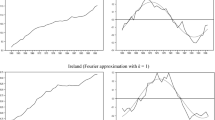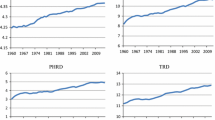Abstract
We propose a new generalization of the concept of cointegration that allows for the possibility that a set of variables are involved in an unknown nonlinear relationship. Although these variables may be unit-root non-stationary, there exists a nonlinear combination of them that takes account of such non-stationarity. We then introduce an estimation technique that allows us to test for the presence of this generalized cointegration in the absence of knowledge as to the true nonlinear functional form and the full set of regressors. We outline the basic stages of the technique and discuss how the issue of unit-root non-stationarity and cointegration affects each stage of the estimation procedure. We then apply this technique to the relationship between health expenditure and health outcomes, which is an important but controversial issue. A number of studies have found very little or no relationship between the level of health expenditure and outcomes. In econometric terms, if there is such a relationship, then there should exist a cointegrating relationship between these two variables and possibly many others. The problem that arises is that we may be either unable to measure these other variables or that we do not know about them, in which case we may incorrectly find no relationship between health expenditures and outcomes. We then apply the concept of generalized cointegration; we obtain a highly significant relationship between health expenditure and health outcomes.
Similar content being viewed by others
References
Baicker K, Chandra A (2004) The productivity of physicians specialization: evidence from the medicare program. Am Econ Rev 94: 357–361
Baltagi B, Moscone F (2010) Health care expenditure and income in the OECD reconsidered: evidence from panel data. Econ Model 27(4): 804–811
Basmann RL (1988) Causality tests and observationally equivalent representations of econometric models. J Econ Ann 39: 69–104
Chang I-L, Hallahan C, Swamy PAVB (1992) Efficient computation of stochastic coefficients models. In: Amman HM, Belsley DA, Pau LF (eds) Computational economics and econometrics. Kluwer Academic Publishers, Boston, MA, pp 43–54
Chang I-L, Swamy PAVB, Hallahan C, Tavlas GS (2000) A computational approach to finding causal economic laws. Comput Econ 16: 105–136
Engle RF, Granger CWJ (1987) Co-integration and error correction: representation, estimation, and testing. Econometrica 55: 251–276
Fisher ES, Wennberg D, Stukel T, Gottlieb D, Lucas FL, Pinder EL (2003) The implications of regional variations in medicare spending, Part 1: the content, quality and accessibility of care. Ann Int Med 138: 283–287
Fisher ES, Bynum JP, Skinner J (2009a) Slowing the growth of health care costs: lessons from regional variation. N Engl J Med 360: 849–852
Fisher ES, Goodman D, Skinner J, Bronner K (2009b) Health care spending, quality, and outcomes. The Dartmouth Institute Policy Brief
Garber AM, Skinner J (2008) Is American health care uniquely inefficient. J Econ Perspect 22: 27–50
Granger CWJ (2008) Non-linear models: where do we go next—time varying parameter models?. Stud Nonlinear Dyn Econom 12: 1–9
Greene WH (2008) Econometric analysis, 6th edn. Pearson Prentice Hall, Upper Saddle River, New Jersey
Hall RE, Jones CI (2007) The value of life and the rise in health spending. Q J Econ 122: 39–72
Jones CI (2005) More life vs more goods: explaining rising health expenditure. FRBSF Econ Lett 2005: 27
Judge GG, Griffiths WE, Hill RC, Lütkepohl H, Lee T (1985) The theory and practice of econometrics, 2nd edn. Wiley, New York
Lehmann EL (1999) Elements of large-sample theory. Springer, Berlin, Heidelberg, New York
Lehmann EL, Casella G (1998) Theory of point estimation, 2nd edn. Springer, Berlin, Heidelberg, New York
Pratt JW, Schlaifer R (1984) On the nature and discovery of structure. J Am Stat Assoc 79:9–21, 29–33
Skinner JS, Staiger D (2009) Technology diffusion and productivity growth in health care, NBER working paper No. 14865
Skinner JS, Fisher ES, Wennberg J (2005) The efficiency of madicare. In: Wise DA (eds)Analyses in the economics of ageing. NBER research University of Chicago Press, Chicago
Swamy PAVB, Mehta JS (1975) Bayesian and non-Bayesian analysis of switching regressions and a random coefficient regression model. J Am Stat Assoc 70: 593–602
Swamy PAVB, Tavlas GS (2001) Random coefficient models, Chap 19. In: Baltagi BH (eds) A companion to theoretical econometrics. Blackwell, Malden
Swamy PAVB, Tavlas GS (2007) The new Keynesian Phillips curve and inflation expectations: re-specification and interpretation. Econ Theory 31: 293–306
Swamy PAVB, Tinsley PA (1980) Linear prediction and estimation methods for regression models with stationary stochastic coefficients. J Econ 12: 103–142
Swamy PAVB, Mehta JS, Singamsetti RN (1996) Circumstances in which different criteria of estimation can be applied to estimate policy effects. J Stat Plan Inf 50: 121–153
Swamy PAVB, Chang I-L, Mehta JS, Tavlas GS (2003) Correcting for omitted-variables and measurement-error bias in autoregressive model estimation with panel data. Comput Econ 22: 225–253
Swamy PAVB, Tavlas GS, Mehta JS (2007) Methods of distinguishing between spurious regressions and causality. J Stat Theory Appl 1: 83–96
Swamy PAVB, Yaghi W, Mehta JS, Chang I-L (2007) Empirical best linear unbiased prediction in misspecified and improved panel data models with an application to gasoline demand. Comput Stat Data Anal 51: 3381–3392
Swamy PAVB, Tavlas GS, Hall SG, Hondroyiannis G (2010) Estimation of parameters in the presence of model misspecification and measurement error. Stud Nonlinear Dyn Econom 14: 1–33
Zellner A (1979) Causality and econometrics. In: Brunner K, Meltzer AH (eds) Three aspects of policy and policy making. North-Holland, Amsterdam, pp 9–54
Zellner A (1988) Causality and causal laws in economics. J Econom Ann 39: 7–21
Author information
Authors and Affiliations
Corresponding author
Additional information
The views expressed in this article are the authors’ own and do not necessarily represent those of their respective institutions. We would like to thank an anonymous referee for comments on this article.
Rights and permissions
About this article
Cite this article
Hall, S.G., Swamy, P.A.V.B. & Tavlas, G.S. Generalized cointegration: a new concept with an application to health expenditure and health outcomes. Empir Econ 42, 603–618 (2012). https://doi.org/10.1007/s00181-011-0483-y
Received:
Accepted:
Published:
Issue Date:
DOI: https://doi.org/10.1007/s00181-011-0483-y




